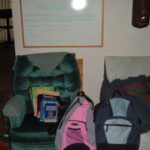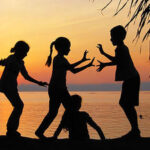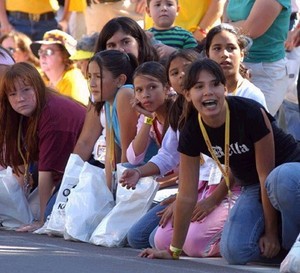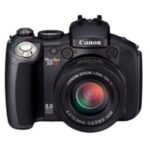Kids love taking photographs and, if given a camera of their own, will usually have it filled twice a day on a regular basis with all kinds of interesting shots, mostly blurry, cloudy, or useless. A child may wish to take a really stunning photograph of something that they find interesting, but unless they understand a few basic concepts of photography, they are more likely to end up with pictures that are ruined or cannot be used.
Simple photography is not difficult to learn, even for younger children. If your unschooler is interested in some easy ways to get some better photographs, you can teach him or her some of these simple techniques that will work with any camera. If you are clueless about photography, you might even find some of these techniques useful for yourself as well.
The first thing that you should do is check out a few books with pictures from the library. Photography books are generally not a good idea as those artists usually go against some of the rules to make an artistic photo. Some photography books can be good, though. National Geographic magazines can tend to be too artsy, but may also work in some cases. It’s best to go with a good educational book with lots of color photographs in it such as nature books. Spend some time looking at those photos and see what techniques those photographers use.
Filling the Frame
When taking a photograph, a child’s first reaction is to stand as far away from the object they are photographing as possible. It’s only natural to want to get the whole image into the shot. Kids think the same way that they see. If they can see everything around them, they assume that a photograph should include as much as possible in it as well.
Instead, show kids how to get close to their subject. When taking a picture of their friend’s funny face, for example, their friend will be a lot more visible if they take the photo from the waist or chest up and with the camera turned on its side. Show kids how to get in close so that the frame is full, but not too close. Generally, leaving a small space around the edges of the subject frames it and makes it look great.
Some of the best photography advice you can give a novice is to get in close! Turn the camera to the side to take shots as well, don’t just show kids how to take photographs horizontally. When taking shots of people like this, you end up with a lot of ugly space to either side of the subject. The length of the subject should fit into the length of the frame. Teach kids how to fill the whole frame of the photo with the point of interest.
Backlighting
Cameras do not see like the human eye. We can usually see everything in a room, but a camera only sees what is brightest. For example, when a person is standing in front of a sunny window, our eyes can see what is outside and also the person’s face. A camera, on the other hand, can only see the brightest thing – what is outside the window – and the person will look like a black shadow with no face standing in front of it. The same thing will happen if you are taking a photograph and the sun is behind the person.
Generally, it’s a good idea to avoid back lighting, but sometimes you can’t. If you can’t get the light out from behind your subject, you can still take a great photo by turning on the flash. The flash will light up the person’s face brightly and you will be able to get both the bright background AND the person or object in the photo.
When taking a photograph toward the light, always remember to use the flash unless a silhouette effect is what you are trying to accomplish.
Close-Up Photos (“macro” shots)
A few of the very newest cameras have a macro setting, but most regular cameras on the market today cannot take close-up photographs without being very blurry. This is because cameras need a special lens to focus on things that are close, the same way people may need reading glasses to see what is close to their face. This can be a real problem if your child wants to take a photograph of something small, like a picture that they have drawn, a favorite toy, or perhaps a small item such as jewelry that they would like to post to an online auction.
Luckily, most cameras these days shoot in a pretty high resolution. This means that you can zoom into photos after you take them and crop them to make things bigger. If you are trying to take a close-up of something small, try instead to back away and take the picture at a point where it is least blurry. You can then go into Photoshop or another photo manipulator and crop just the item you wanted to photograph. The resolution will be slightly lower, but as long as you are shooting in the highest resolution possible, you will usually be able to get a blown-up clear image of the item.
So, when photographing small items, use the highest image resolution and stand back just far enough for the image to not be blurry, then cut and crop the photo so that the subject fills the frame. Also, make sure that the object is brightly lit, preferably out of doors. This will cause the camera to shoot at a higher speed which means it will be MUCH less blurry.
Dark vs. Light
When taking a photograph in a dark area, the camera shutter stays open longer to catch more light which means that even the slightest movement will cause the picture to be blurry or smeared, especially if you are using the zoom feature. If you are shooting in an area with poor lighting or artificial lighting, set the camera on a stable surface or turn on the flash.
Backgrounds (a little more advanced)
If you are trying to take a really nice photograph of something, you might want to get rid of clutter in the background. People walking, buildings, cars, and other things get in the way of a good photo and clutter it up. When taking a portrait, try to find a nice, simple, single-colored background. You could use grass, leaves, a brick wall, the ocean, the sky, or a pile of rocks.
The Rule of Thirds (still more advanced)
The rule of thirds is a bit more complicated than what I will go into here simply because a photograph does not need to follow these rules exactly to look good. Using the rule of thirds can help in some situations, however.
Most people tend to put the subject of their photo directly in the center of the picture. This makes a lot of sense for portrait shots and close-ups. Sometimes, however, it looks better to put your subject a little off to one side. Landscapes, for example, will look better if you put the subject off to one side a little.
If you are photographing a large field with one tree, put the tree slightly to one side of the photo rather than right in the middle. If you are photographing a mountain range, place the largest mountain off to one side. This makes the photograph more appealing to the eye.
Some Recaps of the Rules:
1) When shooting one or two people, turn the camera on its side.
2) Try to get as much of the subject in the frame as possible by getting closer!
3) Don’t hold the camera too close to the subject if it’s small.
4) If the light source is behind your subject, use the flash.
5) If you are indoors or the light is low, use the flash or put the camera on a stable surface.
6) Use simple backgrounds when you can.
7) When shooting landscapes, use the rule of thirds.
These are the easiest techniques to use when taking photographs. If you would like to learn more about taking great pictures, it may be a good idea to invest in an old SLR camera and check out a few books on beginning photography at your local library. Now get out there with your kids and start taking those photos!







